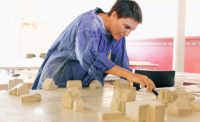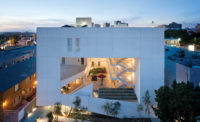Anna Heringer has won the second annual Obel Award for Anandaloy, a community center in rural Bangladesh. The Obel Award is an international prize that honors recent, outstanding architectural contributions to human development, with the winner receiving €100,000 and an artwork by Argentinian artist Tomás Saraceno. (The first Obel Award went to Japanese architect Junya Ishigami last year for his design of Water Garden.)
Anandaloy, which means “Place of Deep Joy” in the local Bengali dialect, is a curved, two-story bamboo and rammed earth structure. It was created of local materials and craftsmanship for a unique purpose: the ground floor is a therapy center for people with disabilities—some of whom were also involved in the construction process—and a fair-trade textile manufacturing workshop for local women is housed above. In 2007, Heringer won an Aga Khan Award for Architecture for a school she designed in Rudrapur, Bangladesh, also made of bamboo and mud.
One of the most important aspects of the design, according to Heringer, is a ramp that “winds and dances” around the structure—the only ramp in the area—creating an inclusive space for the village.
“I think there is a lot of good-looking architecture all around, but I think good looking architecture is not enough,” Heringer, founder of Germany-based Studio Anna Heringer, says in a video interview by the Obel Awards. “It has to bring meaning to people and, of course, add to a healthy planet. And that’s what I’m trying to do.”
This year’s Obel jury members included landscape architect and chair Martha Schwartz, founder, Martha Schwartz Partners; Kjetil Trædal Thorsen, co-founder, Snøhetta; Louis Becker, design principal and partner, Henning Larsen; Dr. Wilhelm Vossenkuhl, professor emeritus of philosophy; and Xu Tiantian, founding principal, DnA.
“To all of us in the jury, Anandaloy is an outstanding project,” Schwartz said in a statement. “It is an original piece. It is not in the style of; it is not imitating something else. I think Anna is absolutely dedicated to what she is doing, which is what you see when you see a good piece of art: that there is a good, focused intent behind it. Anna manages to integrate all of her values: she is building sustainably, using the materials that are there, having people involved, so that they can learn to build for themselves, and creating more opportunities for women and for people with disabilities. You can feel that she has a real respect for the culture, for the people, for the land.”
Watch a video interview with Anna Heringer provided by the Obel Awards.








Post a comment to this article
Report Abusive Comment